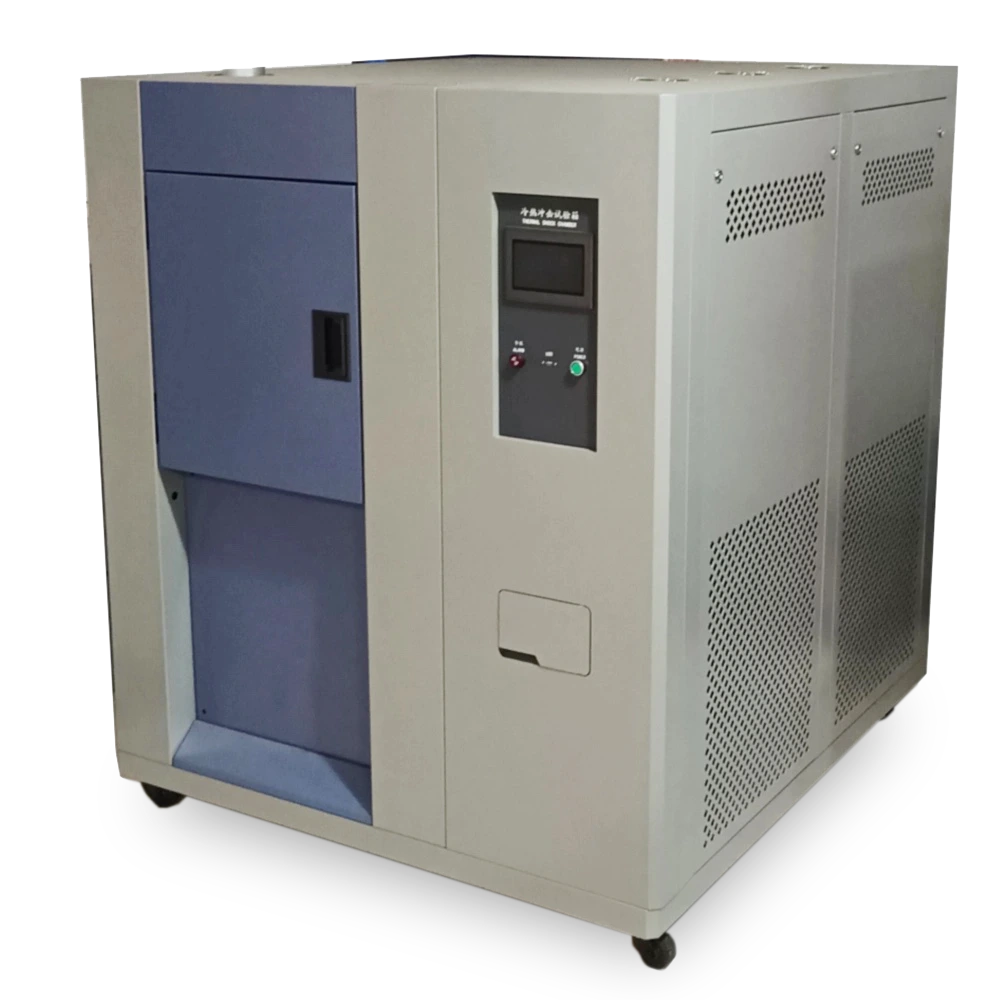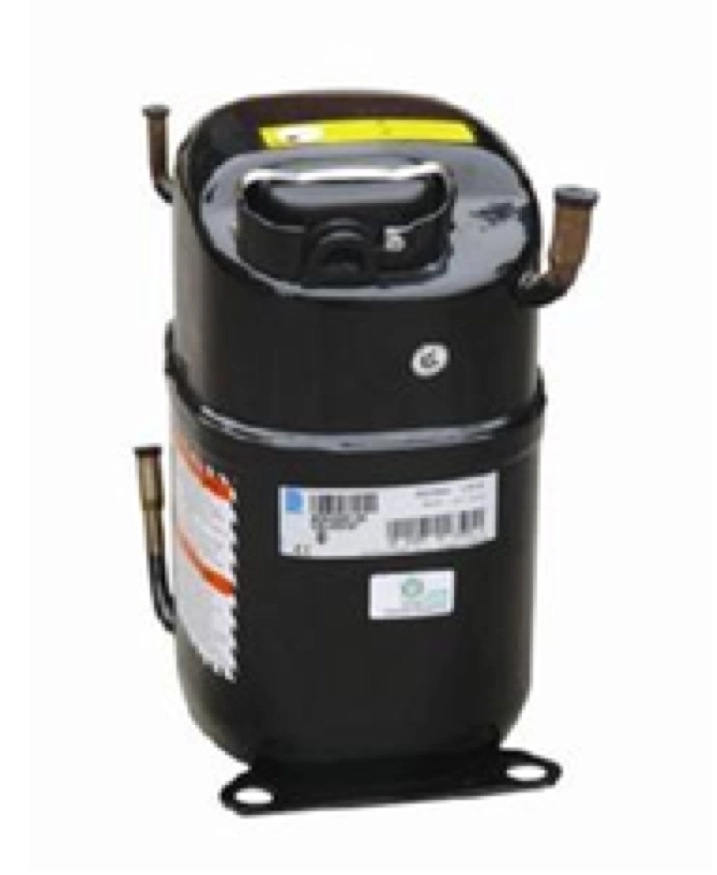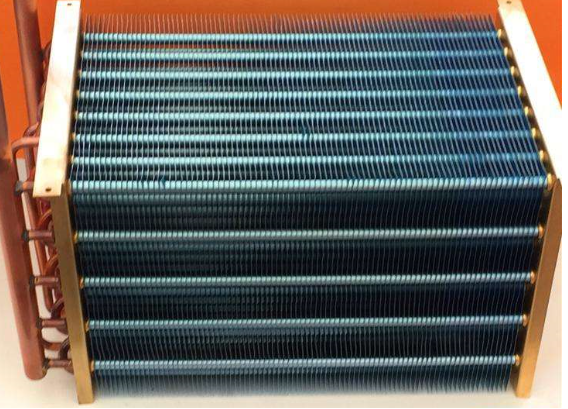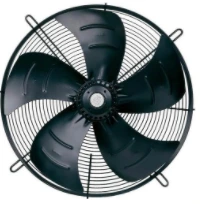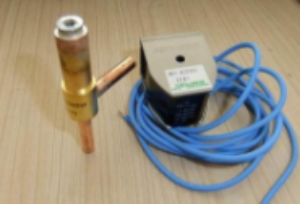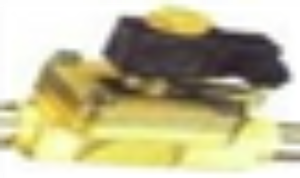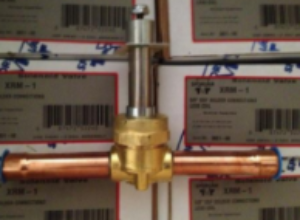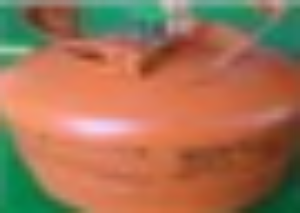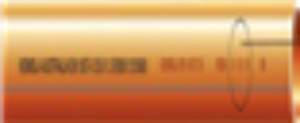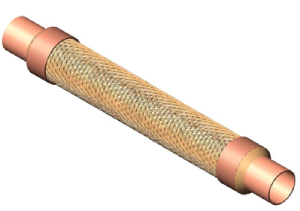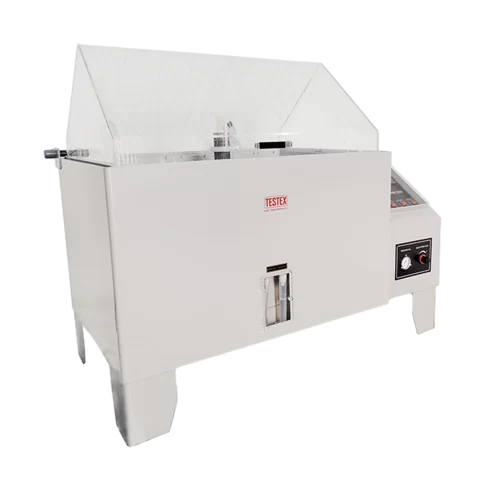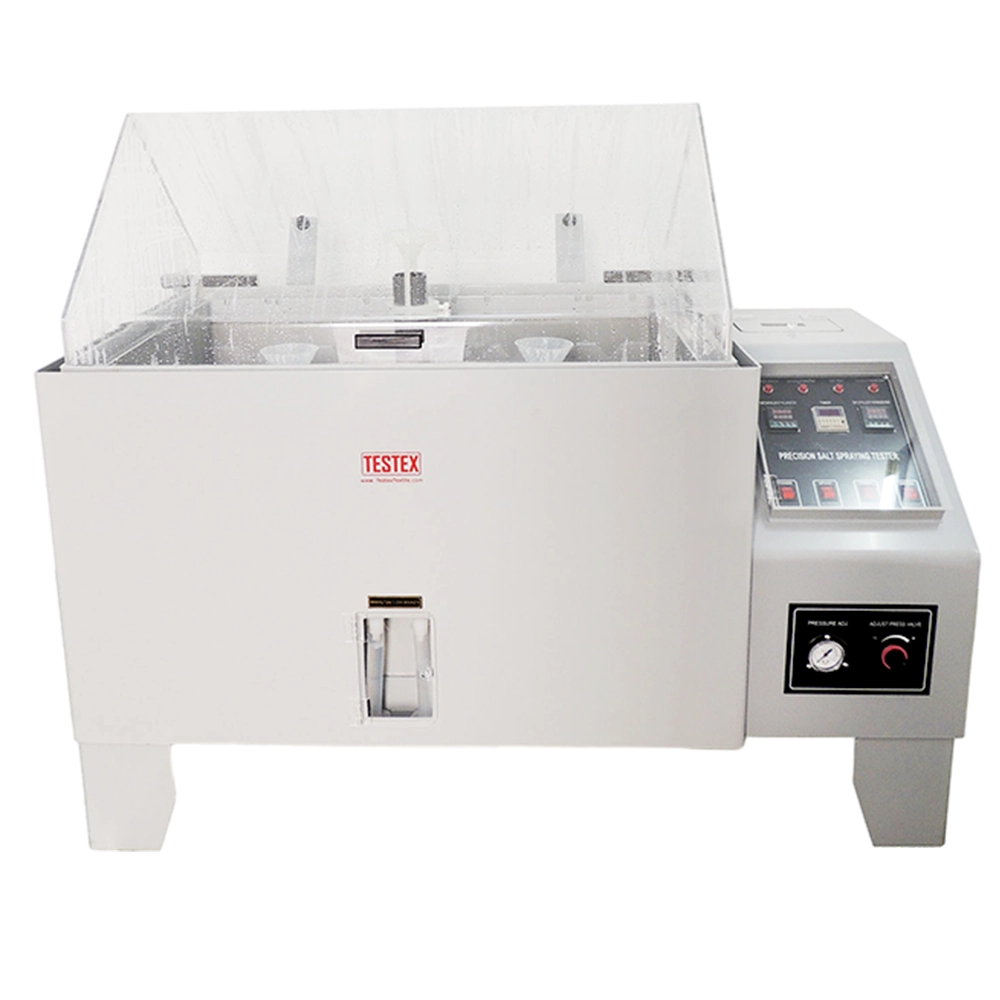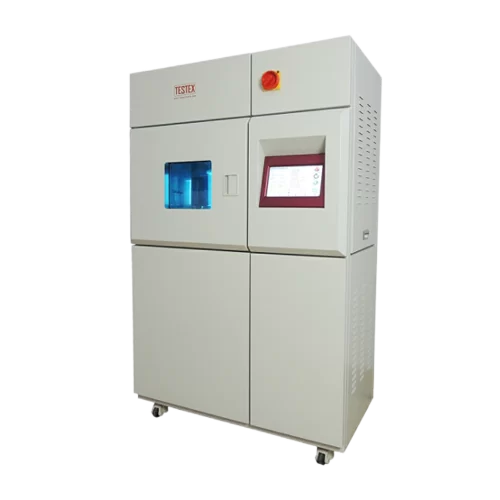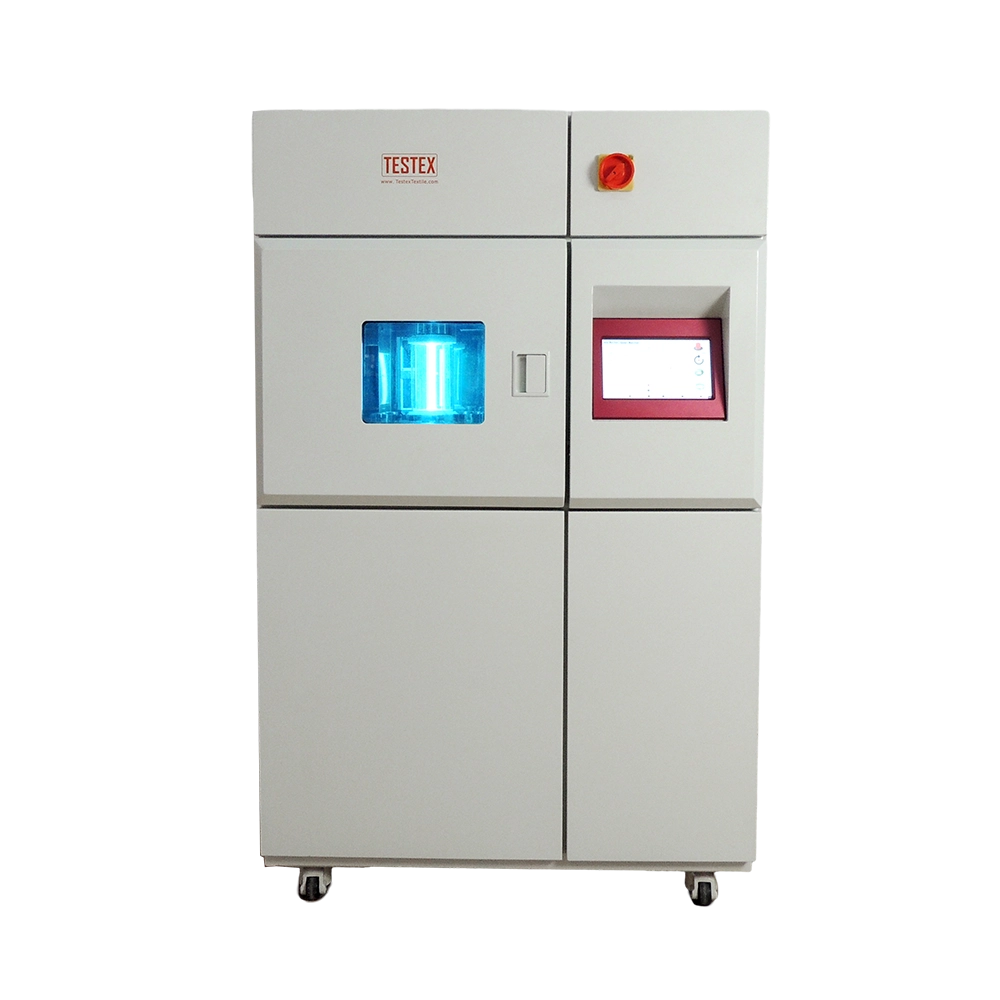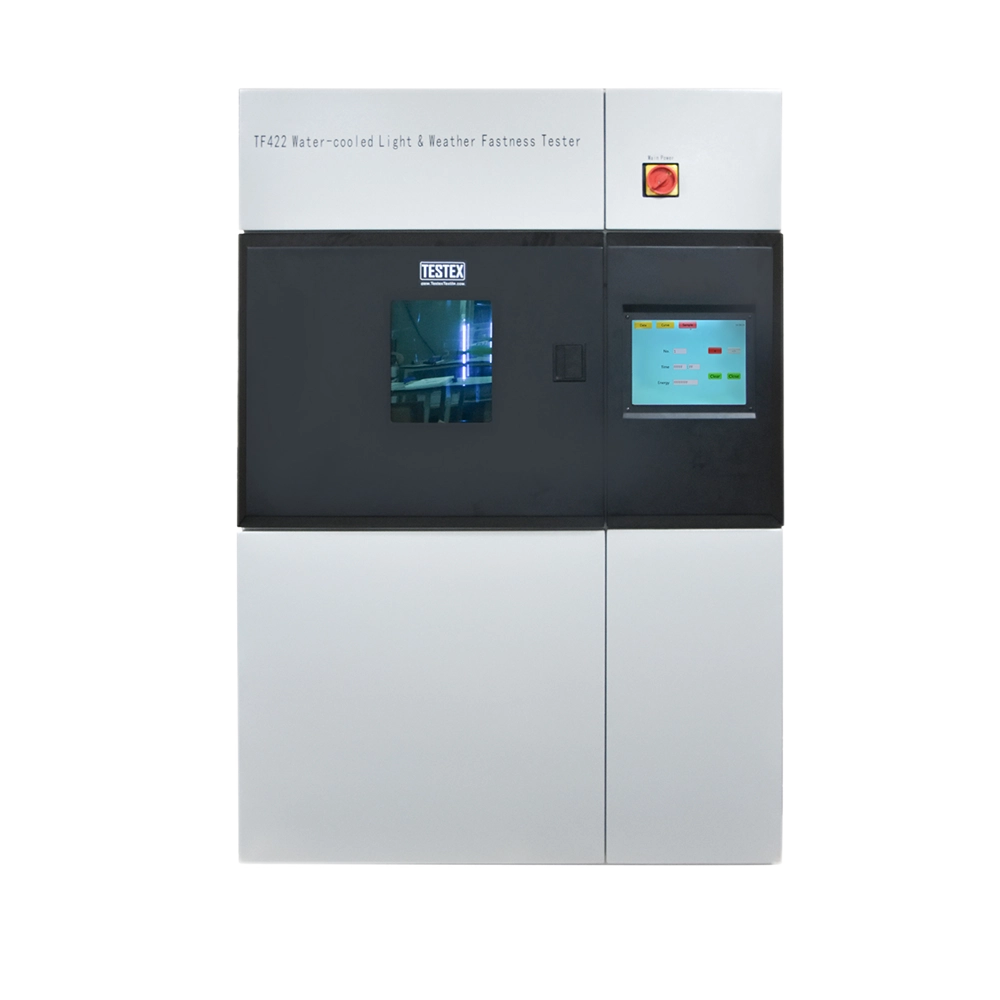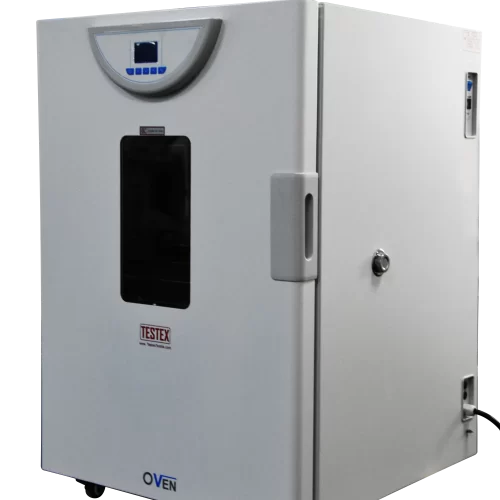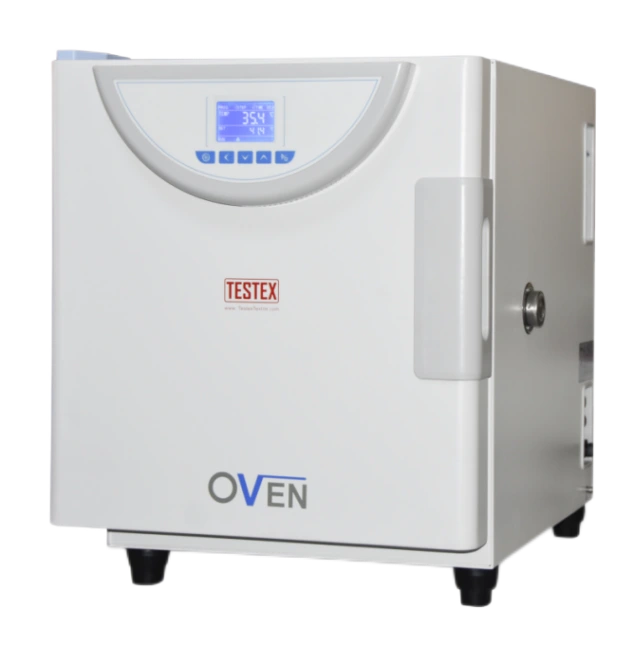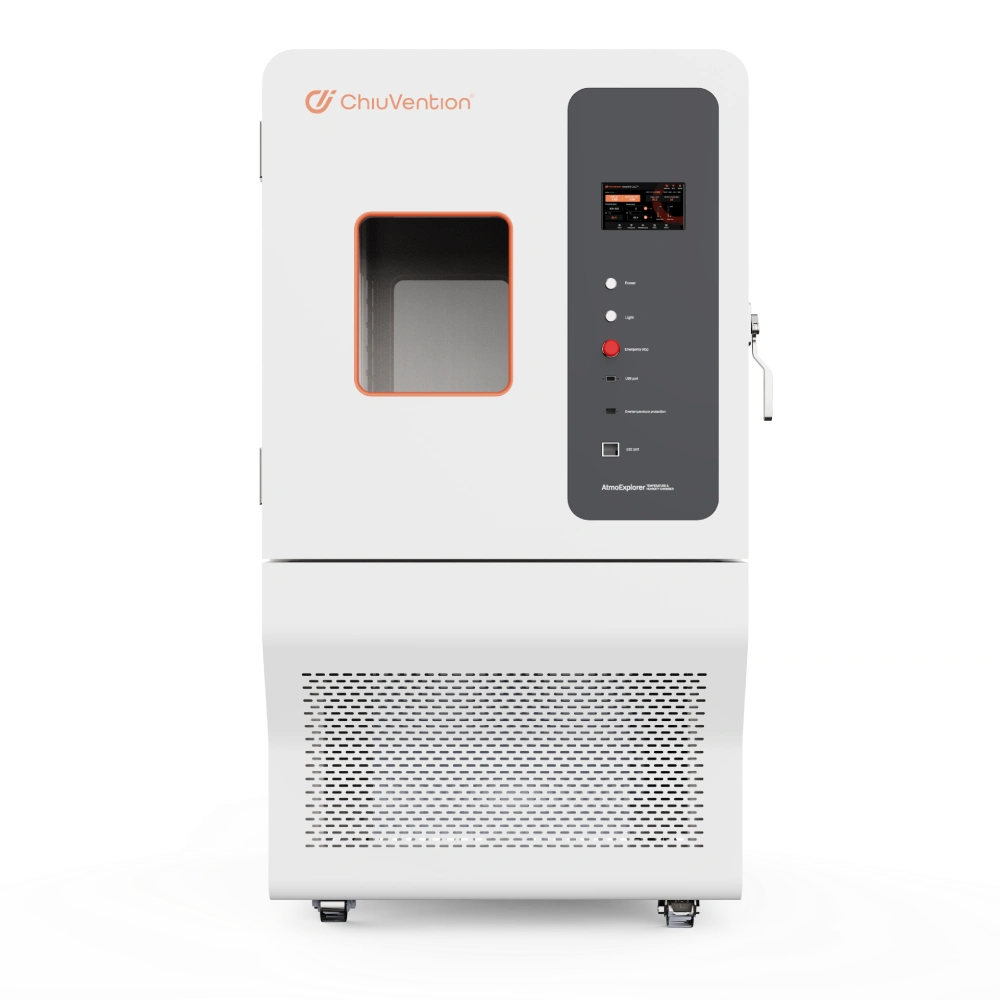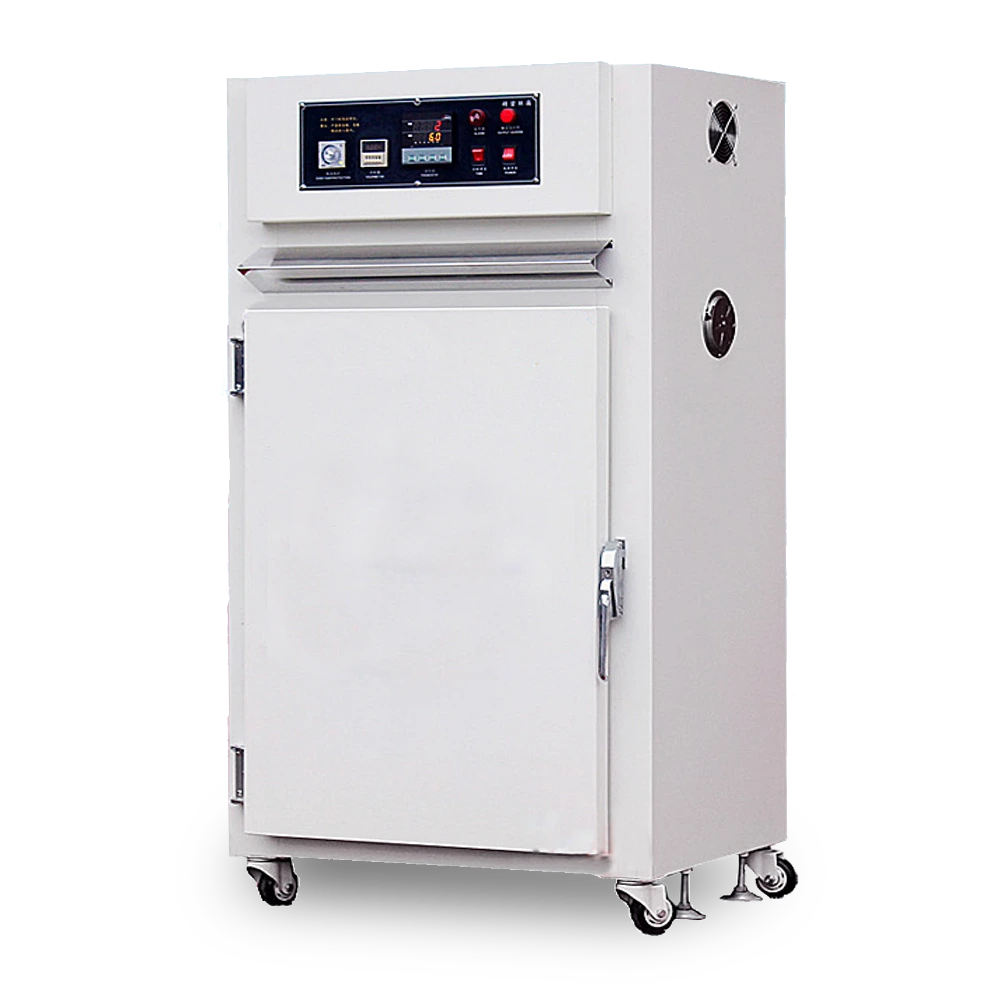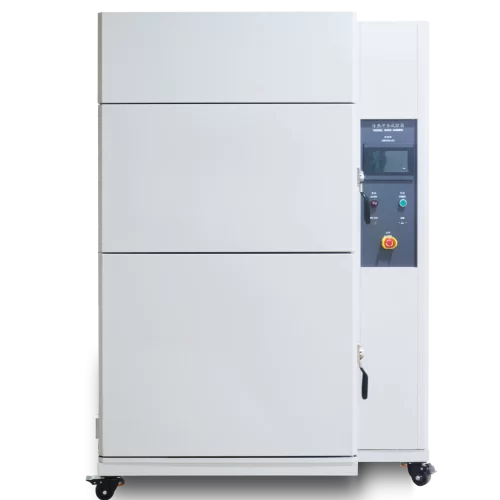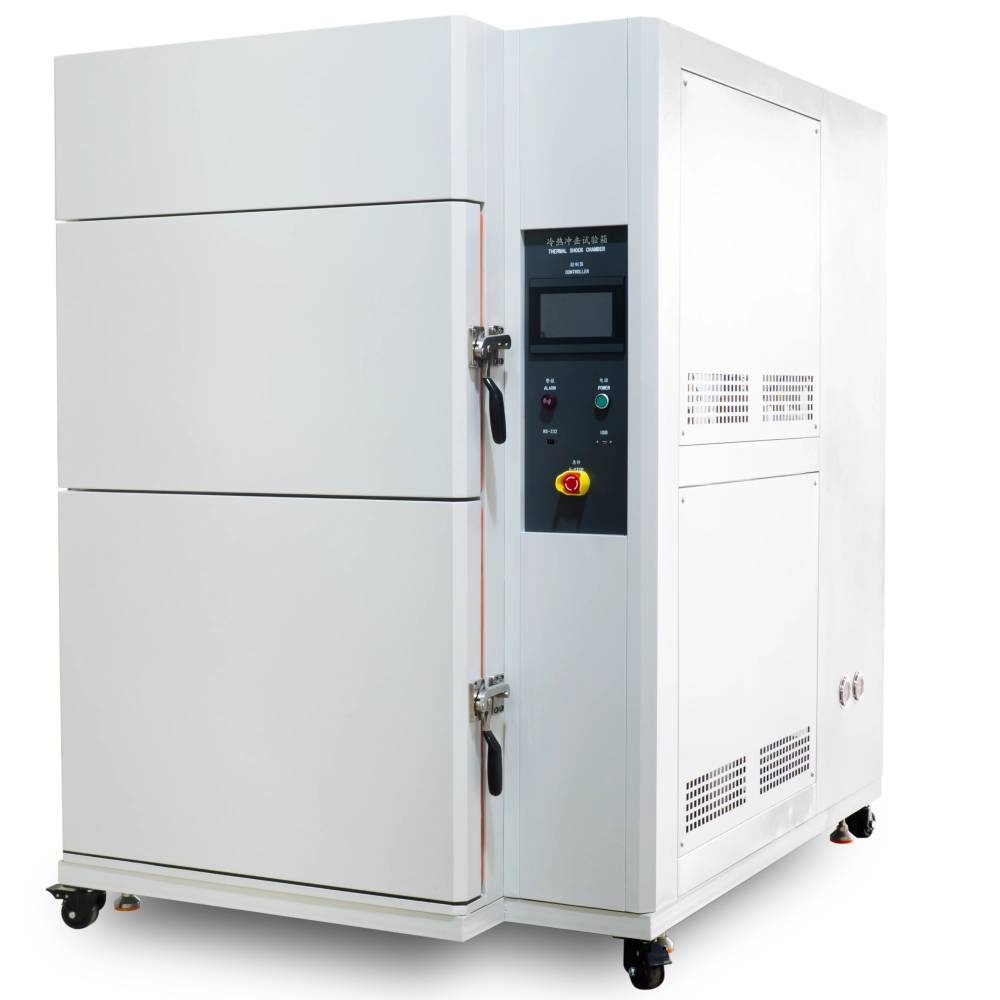Meet our Three-Zone Thermal Shock Tester, expertly designed to test diverse materials. Its cutting-edge capabilities help it excel in this role. It tests electrical and electronic components, metals, chemicals, and more. It works for automation parts, communication components, and beyond. Our tester proves its worth across industries. It is ideal for defense and aerospace applications. It is also good for BGA, PCB substrates, and electronic chips. It works for ICs, semiconductor ceramics, and polymer materials. This state-of-the-art equipment ensures very careful testing of physical traits. If you want a reliable way to raise your material testing standards, seize the opportunity now. Request a quote to unlock the potential for great quality control and product reliability. Your path to superior testing begins here!
Instrument and technical characteristics of three-zone Thermal Shock Tester
1. USB Recording Function: The tester includes a disk USB recording function. It removes the need for an external logger.
2. Refrigerant Servo Valve Flow Algorithm Control: It uses advanced control algorithms for the refrigerant servo valve. This results in a remarkable 30% power saving.
3. High-Temperature and High-Humidity Test Technology: Utilizes industry-leading technology to prevent condensation and dripping during high-temperature and high-humidity tests.
4. Low-Temperature Working Conditions Optimization:
The heater remains inactive in low-temperature conditions.
PWM technology controls the refrigerant flow rate and direction.
The refrigeration unit has adjustable components. These include the refrigeration pipe, cold by-pass pipe, and hot by-pass pipe. They are adjustable in three directions for automatic constant temperature maintenance.
Achieves a 40% reduction in energy consumption under low-temperature conditions.
5. Temperature Synchronization Slope Control: It adheres to IEC 68-2-56 and 68-2-30 standards. This ensures no dripping or condensation during temperature sync.
Control mode of the thermal shock test chamber:
The temperature shock test chamber has a smart control system. It combines low and high-temperature storage with a thermal energy storage tank. Open the DAMPER as needed. This moves energy efficiently from the storage tank to the test tank. This achieves rapid temperature shocks. This process is complemented by a temperature control system (BTC). It has a balance and a specially designed air supply system.
The system uses dynamic P.I.D. control to regulate the Solid State Relay (SSR). This ensures that the heating system equals the heat loss. This control mechanism is meticulous. It lets the chamber run for a long time, ensuring stability..
Thermal shock Chamber Specification
Technical parameters
| Product name | Cold and Thermal Shock Test Chamber | |
| Product Model | JS-TC-80A-40 | |
| Test Method | Pneumatic dampers switch 3 temperature zones, air-cooled | |
| Volume and Size | Nominal content area | 80L |
| Inner box size(W X D X Hcm) | 40X50X40 | |
| Outer box size(W X D X Hcm) | 155x170x185 | |
Specimen limit of three-zone Thermal Shock Tester
The Three-Zone Thermal Shock Tester imposes restrictions on testing and storage under the following conditions:
- Flammable, Explosive, and Volatile Substance Specimens:
- Prohibits specimens containing flammable, explosive, or volatile substances.
- Corrosive Substance Specimens:
- Excludes specimens with corrosive substances from testing and storage.
- Biological Specimens:
- Prohibits the testing or storage of biological specimens.
- Specimens of Strong Electromagnetic Emission Sources:
- Testing and storage of specimens emitting strong electromagnetic signals are not allowed.
- Radioactive Material Specimens:
- Prohibits the inclusion of specimens containing radioactive materials.
- Highly Toxic Substances:
- Excludes highly toxic substances from testing and storage.
- Specimens That May Produce Highly Toxic Substances During Testing or Storage:
- Prohibits specimens that may generate highly toxic substances during testing or storage.
Three-zone Thermal Shock Test chamber performance indicators
Performance indicators are measured under the following test environment conditions:
Test Environment Conditions
- Ambient Temperature: +28℃
- Relative Humidity: ≤ 85%
- Specimen Presence: No specimen in the test chamber (unless otherwise specified)
Test Method
GB/T 5170.2-1996 Temperature Test Equipment
High-Temperature Chamber
- Preheating Upper Temperature: +200 °C
- Warming Time: Room temperature → +150 ℃ ≤ 40min
Note: The temperature rise time signifies the standalone performance of the high-temperature chamber.
Cryogenic Chamber
- Pre-cooling Lower Limit Temperature: -55℃
- Cooling Time: Room temperature → -60 ℃ ≤ 60min
Note: The cooling time represents the standalone performance of the cryogenic chamber.
Test area
- Shock Temperature Range: -40°C to +150°C
- Temperature Deviation: ±2.0°C (at constant, no load)
- Temperature Fluctuation: ≤±0.5℃
- Temperature Changeover Time: 3~5min
- Damper Switching Time: <5sec
- Impact Dwell Time: 15 minutes or more
Recovery Conditions
- Specimen Weight (Evenly Distributed): ≤10KG
- Sensor Position: Measurement position at the air outlet
| High-temperature exposure | Specimen weight | Low-temperature exposure time |
|---|---|---|
| +150℃:30min | ≤10KG evenly distributed | -40℃:30min |
Meeting Test Standards:
GB/T 2423.1-2001 Test A: Low-temperature test method
GB/T 2423.22-2002 Test N: Temperature change test method Test Na
GJB 150.3-1986: High-temperature test
GB/T 2423.2-2001 Test B: High-temperature test method
GJB 150.4-1986: Low-temperature test
GJB 150.5-1986: Temperature shock test
Structural characteristics Of thermal shock chamber
Insulation Enclosure Structure
- Material:
- Cold-rolled steel plate, electrostatic double-sided spraying, 1.5MM (2MM in the four-legged part)
- Inner wall material: Stainless steel plate SUS304, 2.0MM thickness
- Box insulation material: Rigid polyurethane foam + glass fiber
- Door insulation material: Glass fiber
Test Area Door:
- Single door with a hinge on the right (when facing the box)
Heater
High Temperature Box:
Nickel-chromium alloy electric heater
Low Temperature Box:
Nickel-chromium alloy electric heating wire type heater
Heater Control Mode:
Non-contact iso-periodic pulse width adjustment, SSR (solid-state relay)
Drive Unit
- Dampers and test area door locking device (pneumatic drive)
- Cylinder: For low-temperature / high-temperature exposure
Circulation Fan
- High-Temperature Exposure: Centrifugal type
- Low-Temperature Exposure: Centrifugal type
- Room Temperature Exposure: Centrifugal type
Main Structure
- Pre-cooling and Cold Storage Area
- Preheating and Heating Storage Area
- Testing Area for Testing Products
- Three parts of the main structure, flap-type control
- Box weight ≥ 200 Kg
Sealing Device
Original, imported high-quality silicone sealing strip
Inner Shelf of Test Chamber
2 x adjustable grill shelves with a single load of a minimum 30 Kg

Machine Caster
Utilizing a versatile and multifunctional pulley facilitates easy movement, allowing for adjustments in placement, and ensures a secure fixed position with robust bolts.
Alarm Indicator(optional)
One alarm indicator
One tricolor light
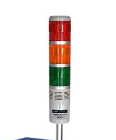
Refrigeration system
Refrigeration Method
The refrigeration method employed is air-cooled, utilizing mechanical compression through a binary stack system.
Compressor
Terracon France
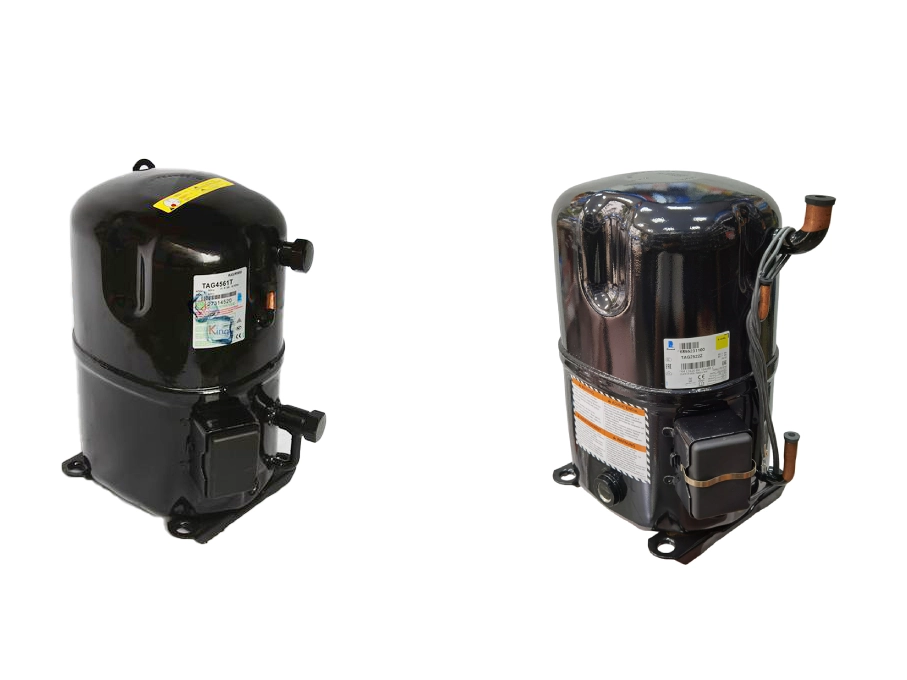
Refrigerant
High-temperature machine: R404A (Ozone depletion index is 0)
Low-temperature machine: R23 (Ozone depletion index is 0)
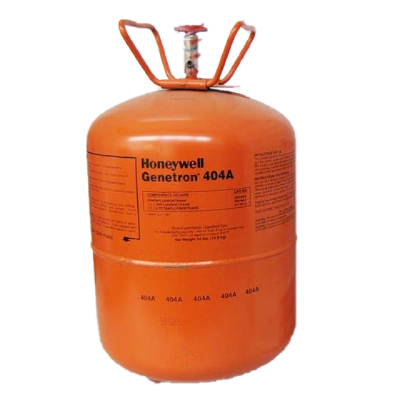
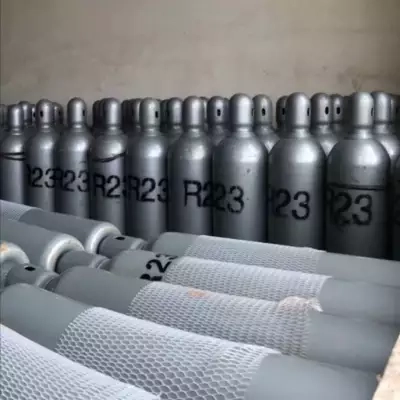
Heat Exchanger
We use an imported, fully-welded, high-efficiency ST plate heat exchanger. We do not use the low-end option. It is only half-welded or disassembled.
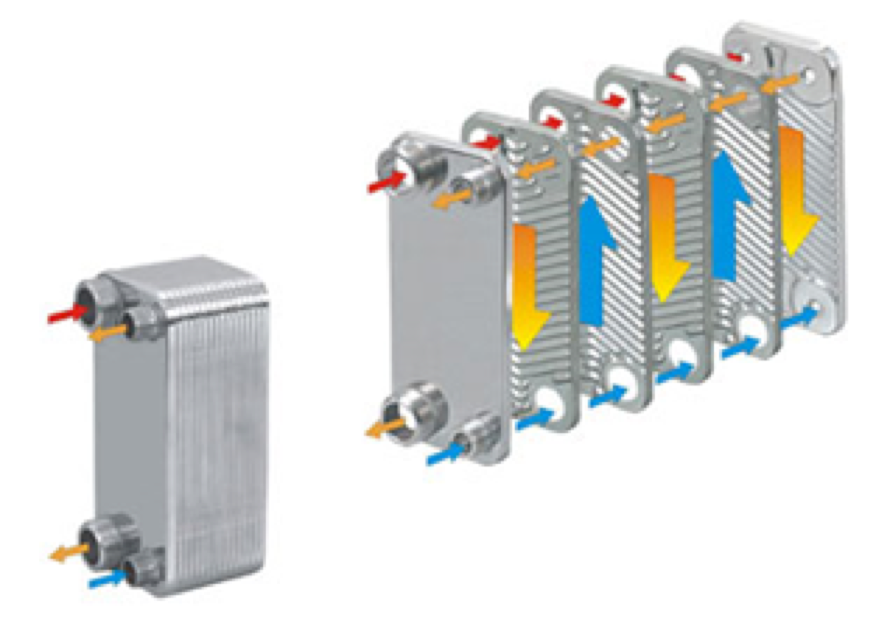
Condenser
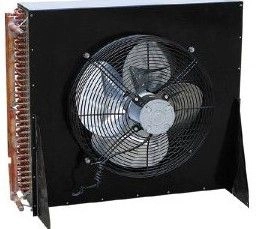
Evaporator
The evaporator has a high-efficiency, multi-sectional design. It has hydrophilic membrane fins. They are thicker.
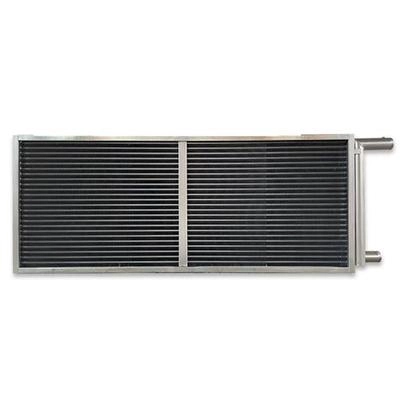
Throttling Device
The refrigeration system incorporates both a thermal expansion valve and a capillary tube.
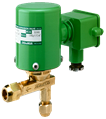
Chiller Control Mode
The control system regulates the refrigerator’s operation. It does this autonomously, based on the test conditions. It uses a refrigerant servo valve flow rate algorithm.
Basic Circuit
thermal shock test chamber Electrical control system
Controller
The system utilizes an industrial microcomputer controller from Taiwan. Featuring anti-integral saturation PID, BTC balanced temperature control mode with thermal compensation function. And DCC intelligent cooling control. Additionally, DEC intelligent electrical control, including temperature test alternating test program settings. This can be customized by DGBLL company to meet specific user requirements.
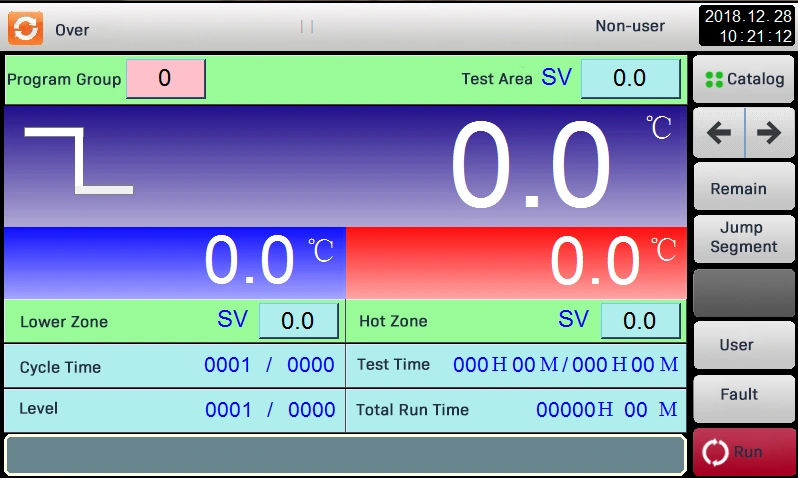
Display System
Thermal shock chamber has a 7-inch hi-res color LCD touchscreen. It has a resolution of 850*680. The interface is in English and Chinese.
Operation Mode
(1)Program mode
(2)Constant value mode
| Programmable touch screen | High-precision resistive touchscreen |
| Force input mode | 3 groups of inputs: support PT100, thermocouple T, K, E, etc. |
| Output mode | PID+SSR/SCR automatic forward and reverse bi-directional synchronous output. |
| Accuracy | 0.1 high precision sampling, temperature: 0.1℃ |
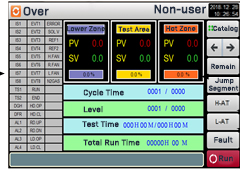
Built-In
Integrated features include:
- Large Storage Space: Capable of saving three months of continuous data with 24 hours of power-on operation.
- 1M Sampling: Provides substantial storage capacity, equivalent to computer storage, for efficient data sampling.
Communication Function
- Self-USB Interface:
- It enables the download of historical curves and data.
- Serves as an alternative to traditional recorders.
- Communication Methods:
- Supports RS485, LAN (network port), GPRS (cell phone), and other communication methods.
- Facilitates convenient remote monitoring and data acquisition.
- USB Function:
- Operates on USB 2.0.
- Allows the recording and downloading of test operation data.
Defrost Setting
- Automatic Setting Times
- Manual Setting Times
Defrost Frequency:
- Meets 200 cycles per time (applicable in the range of -40°C to 150°C).
- Customization is available upon request.
Fault Alarm Function
The system features easy prompts in Chinese and English. They show fault causes and troubleshooting methods. It can monitor 16 groups of fault alarms at once. It triggers matching outputs.
Setting Function
The system supports automatic or manual energy storage compensation. It allows for pre-heat treatment before impact. It also allows for pre-cooling and time-keeping. Additionally, users can configure separate cold or hot flush settings.
Online Function
- Offers a robust communication environment.
- Supports a multi-branch structure with the capacity to accommodate 254 branches simultaneously.
Four Ways to End
- Stop after a Temperature Shock:
- The test concludes after a room-temperature shock.
- Stop after Frost:
- The test concludes after the frost phase.
- Ready State, Direct Stop:
- The system enters a ready state and stops directly.
- Select after Restoration of Power:
- Options for selection after power restoration:
- “Continue”
- “Restart”
- “Stop”
- Users can choose the desired setting following a power failure and restoration.
- Options for selection after power restoration:
Program Storage Capacity
Smart Screensaver Function
- Screen Protector:
- Incorporates a screen protector for enhanced display durability.
- Screen Protection Time Setting:
- Allows users to set the duration for activating the screen protection function.
- Password Authority Setting:
- Provides password authority settings for machine operation, ensuring secure access and control.
Working Principle
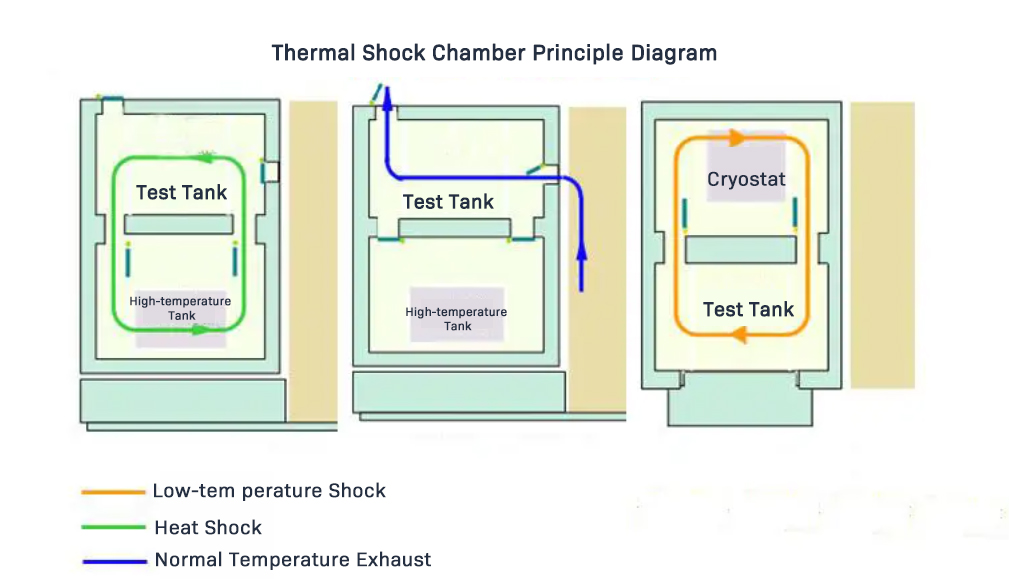
thermal shock chamber Safety protection device
Refrigeration System
- Compressor Overpressure Protection:
- Ensures safety by implementing protection mechanisms against compressor overpressure.
- Compressor Electric Overheating:
- Safeguards the system by detecting and preventing electric overheating of the compressor.
- Compressor Motor Overcurrent:
- It implements protective measures. They prevent motor overcurrent in the compressor. This keeps the system working well.
Electrical System
- Adjustable Over-temperature Protection:
- Features adjustable over-temperature protection for maintaining optimal conditions.
- Test Space Temperature Fuse:
- Incorporates a temperature fuse in the test space for additional safety.
- Air Conditioning Channel Overtemperature:
- Monitors and guards against overtemperature in the air conditioning channel.
- Leakage Short Circuit Protector:
- Includes a protection mechanism to detect and respond to leakage short circuits.
- Total Power Phase Sequence Protection:
- Safeguards the system by ensuring proper power phase sequence.
- Overload Circuit Break Protection:
- Implements circuit break protection to prevent overloading of the system.
- Load Short Circuit Protection:
- Detects and addresses short circuits in the load for enhanced safety.
ChiuVention thermal shock chamber Standard distribution
- Power Cable:
- Five lines (four-core cable + protection ground wire).
- Approximately 2.5 meters long.
- Quantity: 1
- Test Hole:
- Quantity: 50
- Laminate Layers:
- Two layers are provided for placing the product.
- Product Manual:
- Quantity: 1
- Factory Test Report:
- Quantity: 1
- Third-Party Test Report:
- Optional (additional cost covered by the customer if chosen).
temperature shock test chamber Packaging and transportation
- The thermal shock test chamber is integral, allowing for the transportation of the entire unit.
- The maximum transport size (without packaging) is indicated by the parameter outer box size.
Conditions of use
- Ensure the ground is flat at the installation site.
- Provide good ventilation and ensure there is no strong vibration around the equipment.
- Avoid a strong electromagnetic field in the vicinity of the equipment.
- Keep away from flammable, explosive, corrosive substances, and dust in the surroundings.
- Ensure the presence of a drainage floor drain near the equipment.
- The ground bearing capacity of the site should be not less than 1500kg/m².
- Keep at least 800mm of space around the four sides. Also, keep 800mm of space above the test box. This will make it easy to use and maintain.
Environmental Conditions
(1)Temperature: 5℃~35℃
(2)Relative humidity: ≤85%
Air Source (Compressed Air)
(1) Air pressure: 86 kPa ~ 106 kPa
(2) Air source (compressed air) pressure: (4 ~ 7) kg/cm2
Connection pipe diameter: φ8mm
Power Supply Conditions of the Thermal Shock Tester
- Power supply: AC380V 50Hz three-phase four-wire + protection ground.
- Allowable voltage fluctuation range: AC (380±38)V.
- Frequency allowable fluctuation range: (50±0.5) Hz.
- Protection earth ground resistance should be less than 4Ω.
- Power supply mode: TN-S mode or TT mode power supply.
User Responsibilities:
The user is required to:
- Configure an air or power switch of corresponding capacity for the equipment at the installation site.
- Ensure that the switch is independent of the use of this equipment.
Equipment Power About (kw)
20KW
Requirements for Storage Environment
- When the equipment is not in operation, maintain the environmental temperature within the range of 0℃ to +45℃.
- In conditions where the ambient temperature falls below 0℃:
- Ensure clean discharge of water stored in the equipment.
- This precaution prevents freezing and expansion of water in the pipeline, avoiding potential damage.
Machine Weight About (kg)
800KG
thermal shock test Machine and equipment delivery time
Spot goods and all needed gear will be delivered to the buyer’s site. Then, the installation and commissioning will conclude. Subsequently, the equipment will be ready for use after acceptance and confirmation. Please be advised that tasks like lifting, removing doors, or changing walls are not our job.
thermal shock test Equipment main accessories
Electrical Components
Air Supply Temperature Measurement System
Refrigeration Design System Core Configurations of Our Thermal Shock Tester

Compressor
Brand: Taikang, France
Genuine original quality and price better than the industry’s chosen brands
Condenser
Brands: Taiwan Yongqiang
Quality and price better than the industry’s choice of brands, the industry’s best brands.
Evaporator
Brands: Taiwan Yongqiang
Our product beats the best brands in quality. It also has a better price.
Fans
Brands: Germany Mal
Our product is better than the industry’s top brands. It offers higher quality and a lower price. It even beats the best industry brands.
Compressor Pressure Protection
Brands: Danfoss Denmark Import
Our product has genuine quality. Its price is better than the industry’s top brands.
Water Pressure Protection
Brands: Danfoss Denmark Import
Authentic originals cost more and are better than the industry’s selected brands.

Heat Exchangers
Brands:Jiangsu Yuanzhuo
Real originality is cheaper and better than the industry’s brands.
Drying Filter
Brands: Danfoss Denmark Import
Sincere originality at a lower cost and of higher quality than the brands in the industry
Pressure Protection Switch
Brands: Danfoss Denmark Import
Real products are not only cheaper but also better than the brands the industry chose.
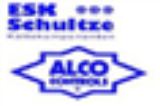
Oil Separator
Brands: USA Emerson
Our product is cheaper than the favored brands. It also offers true quality.

Refrigerant Oil
Brands: U.S. Ice Bear
Our product is cheaper than the industry’s chosen brands. It also has real quality, which makes it stand out.
Solenoid Valve
Brands: Japan Heron Palace
Our product is better than the industry-selected brand. It has more authentic quality and is cheaper.
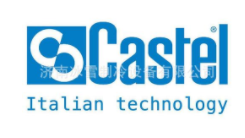
Solenoid Valve
Brands: Italy Casto
Genuine original quality and price is better than the brand chosen by the industry.
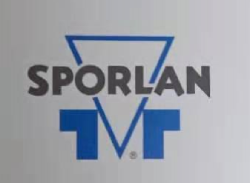
Solenoid Valve
Brands: Sporlan, USA
Genuine original quality and price is better than the brand chosen by the industry.
Refrigerant R23+404A
Brands: Honeywell, USA
Genuine original quality and price is better than the brand chosen by the industry.
Copper Tube
Brands: Australia KEMBLA
Genuine quality and price is better than the brand. The brand is chosen by the industry (foreign investment in China Hengkang manufacturing).
Copper Pipe Elbow
Brands: Australia KEMBLA
Our product shows true quality. It has a better price than the industry’s chosen brand. The brand is made by foreign investors in China Hengkang.
Copper Pipe Straight Through
Brands: Australia KEMBLA
Our product is made in China by international investors like Hengkang. It has real, original quality and costs less than the industry standard.
Copper Tube Nano
Brands: Australia KEMBLA
The industry’s chosen brand is lower quality. It costs less than our original product (made in China by foreign investors).
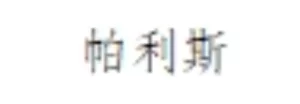
Shock-Absorbing Hose
Place of Origin: United States
Our product beats the top brands in quality. It also costs less. This makes it one of the best.
FAQ About thermal shock chamber
- The temperature conversion rate varies between tests. In the cold and thermal shock test, the temperature conversion rate is exceptionally rapid, with temperature changes occurring suddenly in the process. For instance, in the macro-zhan technology’s two-box basket-type cold and thermal shock test chamber, the temperature conversion time is less than or equal to 10 seconds. In contrast, general temperature cycle tests do not prioritize sudden temperature changes, and the temperature rises and falls at a rate of approximately 1 to 3 degrees Celsius per minute.
- Cold and heat shock tests do not include humidity testing, whereas temperature cycle tests offer the option to include humidity testing.
- The difference in stress loading mechanisms distinguishes temperature cycling tests from thermal shock tests. Thermal shock testing identifies sample failure resulting from fatigue damage and creep, while temperature cycling detects sample failure due to shear fatigue.
- It’s important to note that cold and thermal shock tests permit the use of two-tank-type testing equipment, while temperature cycling tests require the use of a single-tank-type testing equipment.
Exposure to extreme temperatures can have several adverse effects on materials:
- Rubber and Flexible Materials:
Elasticity is reduced, and rupture may occur.
- Plastics and Metals:
Increased brittleness may lead to breakage or cracking.
- Electronic Components:
Changes in temperature can alter electrical parameters, affecting the electrical properties of the product.
- Structural Damage:
Icing or frosting may cause structural damage or moisture-related issues.
- Lubricants:
Increased viscosity of lubricants, resulting in reduced flow capacity and diminished lubrication.
- Material Shrinkage:
Shrinkage of materials may cause changes in the mechanical structure of the product.
- During testing, exercise caution to prevent damage to the rubber edge on the door of the test chamber. Any harm to the rubber edge can impact the service life of the test chamber. To prevent dust from entering the equipment and compromising performance, ensure cleanliness around the bottom of the test chamber and the surrounding ground.
- Regularly inspect the refrigeration system, which is the machine’s core. Check all copper tubes for leakage every six months. If there is any oil leakage from the couplings and welded ports, promptly notify the company or address the issue directly.
- Maintain the high-current contacts in the switchboard and distribution room by cleaning them at least once a year. Loose contacts can lead to dangerous working conditions, ranging from burned components to fire hazards and personal injuries. Utilize a vacuum cleaner to remove dust from inside the room.
- Be cautious with the over-temperature protector settings in the switchboard box. Do not attempt to adjust them arbitrarily, as the factory has already set them. These protection switches are in place to safeguard against heating tube burnout and trigger alarms. The set point is equal to the temperature set point +20℃ to 30℃.
- When retrieving the test product at the end of the testing period, ensure the equipment is in a shutdown state. Staff members handling the product must wear dry, anti-electric, and temperature-resistant gloves.
- Regularly clean and maintain both the interior and exterior of the box. Remove internal impurities before operating the machine.
- Perform an annual cleaning of the distribution room to eliminate dust. Use a vacuum cleaner for interior cleaning, and wipe the exterior of the cabinets with soapy water.
Here are several methods available for conducting cold thermal shock tests:
- Cyclic test method
- Rapid temperature change test
- Temperature shock test
- Programmed temperature rise and fall
- Comprehensive temperature test
In summary, electronic product manufacturers have various options for cold thermal shock tests, and they can choose the method that best suits their specific needs. To ensure the accuracy and reliability of these tests, manufacturers should pay attention to factors such as equipment selection, equipment calibration, and the scientific nature of the testing procedures.
The impact test is influenced by dynamic forces, leading to various factors that affect the accuracy and dispersion of the test results. The primary influencing factors include material factors, sample processing and preparation factors, and other considerations in the testing environment.
- Material Factors:
- Chemical composition, metallurgical microstructure, particle size, presence of segregation, white spots, cracks, and non-metallic inclusions exceeding standards impact the sample’s metallurgical defects.
- Overheating, overcooking, tempering cellular, and other thermal defects in the material influence the impact properties, leading to greater dispersion in impact test results.
- Sample Processing and Preparation Factors:
- (1) Sampling Direction: Sampling along the rolling direction with a notch perpendicular to it results in higher impact values, while sampling perpendicular to the rolling direction with a notch along it yields lower impact values.
- (2) Notch Processing Quality: The size and surface quality of the specimen’s notch significantly affect its impact performance. Rough notch roots, low notch roots, and machining traces parallel to the notch axis can decrease impact performance.
- (3) Specimen Size: Increasing the width or height of the specimen increases the volume of plastic deformation during impact, resulting in higher absorbed energy. The specimen’s notch size determines the concentration of stress near the notch, affecting the specimen’s impact energy absorption.
- Reduced elasticity of flexible materials, such as rubber, and rupture;
- Increased brittleness of metals and plastics, leading to rupture or cracks;
- Changes in the electrical parameters of components affect the product’s electrical properties.
- Icing or frosting causing structural damage to the product or exposure to moisture;
- Increased viscosity of lubricants, reduced flow capacity, and reduced lubrication;
- Changes in mechanical structure caused by material shrinkage.
A thermal shock test chamber is a testing equipment. It can instantly switch from high to low temperature. It is generally used to test material structures or composite materials. Tests how well a material can withstand an environment of extremely high and low temperatures. At the same time, thermal expansion and contraction can cause chemical changes or physical damage. They can be detected quickly in the specimen.
In practice, you can specify the cold and thermal shock test’s duration based on these factors:
(1) The use conditions of the material:
Different materials are subject to different temperature changes under different use conditions. So, when doing the thermal shock test, specify the test’s duration based on how the material will be used.
(2) Practical needs:
The test’s duration should also be set based on practical needs. For example, if we need to test how durable a material is at extreme temperatures, we should increase the test’s duration.
(3) Test standards and industry specifications:
Different test standards and industry specifications have different rules. They vary for the duration of thermal shock testing. So, refer to the test standards and codes. They will tell you how long the thermal shock test should be.
Thermal shock is the result of a sharp heating or cooling of an object, which produces a large amount of heat exchange in a relatively short period of time, leading to a drastic change in temperature, thus generating shock thermal stresses. This phenomenon is commonly found in metallic materials. When a metallic material is subjected to rapid heating and cooling, a large temperature difference occurs within it, causing a large shock thermal stress. For example, in steam turbines, the main causes of thermal shock include the mismatch between the steam temperature and the metal during start-up, the thermal stresses generated during start-up in the extremely hot state due to the steam temperature being lower than the metal temperature of the cylinder and the rotor, and the sharp change in the temperature of the metal in the through-flow part when the load changes drastically.
1. Physical factors
(1) Glass vials and optical instruments broken.
(2) Clamping or loosening of moving parts.
(3) Different contraction/expansion rates of materials or inconsistent induced strain rates.
(4) Cracking of surface coatings, deformation or rupture of parts.
(5) Leakage from sealed compartments.
(6) Failure of insulation protection.
2. Chemical factors
(1) Separation of components.
(2) Chemical reagent protection failure.
3. Electrical factors
(1) Changes in electrical and electronic components.
(2) Rapid condensation or frost caused by electronic or mechanical failure.
(3) Excessive static electricity.
- Temperature control accuracy: for the need to accurately control the temperature of the test project, you need to choose a high control accuracy of the hot and cold temperature shock tester.
- Operation and control system: test samples in different environments, such as quality indicators need to operate the control system is simple and convenient, and can flexibly design different experimental programmes.
- Test chamber size: need to choose the appropriate size of the test chamber according to the actual needs to ensure that the sample can be placed and tested at different temperatures.
- Refrigeration and heating mode: At present, there are two main cooling and heating modes in the thermal shock test chamber, i.e. mechanical and liquid nitrogen. Mechanical type is suitable for small test chamber, liquid nitrogen type is suitable for large test chamber or need to reach the target temperature in a very short period of time test project.
- Safety performance: the need to choose the hot and cold temperature impact tester in line with safety standards, and take into account the safety measures in the test chamber, such as fire, explosion, etc..
- The equipment itself: for example, the heating element or temperature sensor is damaged or malfunction.
- Environmental factors: for example, the ambient temperature or humidity conditions around the test chamber may affect the temperature control inside the test chamber.
- Perational problems: for example, the test box is not used in the correct way, or the operator does not understand how to properly set and control the temperature and other parameters.
- Check the equipment itself to ensure that the heating element and temperature sensors are operating normally. If there is a problem with the equipment, it needs to be repaired or replaced in time.
- Adjust the environmental conditions around the test chamber, such as adjusting the room temperature or humidity and other parameters to ensure that the temperature control inside the test chamber is more stable.
- Ensure that the operator has sufficient skills and knowledge about how to properly set and control the temperature and other parameters of the test chamber. If required, training and guidance can be provided.
- Sometimes it may also be a cold thermal shock test box wall of the heat conduction is not smooth, resulting in high-temperature box leakage of heat or cold leakage of low-temperature box heat loss, in order to compensate for the loss of the inevitable air supply temperature difference, high-temperature box air supply temperature is higher than the box temperature, while the low-temperature box air supply temperature is lower than the temperature of the box, the temperature difference between this air supply also makes the test box box to produce the temperature is not uniform may be.
- Cold thermal shock test box box temperature is not uniform due to the box wall six-sided heat transfer coefficient is not equal or because there are threading holes and other local heat transfer, but also so it will make the box wall radiation convection heat transfer is not uniform, affecting the temperature uniformity of the test box.
- If the cold thermal shock test box chamber put enough to affect the overall internal heat convection test samples, it will affect the internal temperature uniformity to a certain extent, such as LED lighting products, the products themselves have a luminous heat, become a thermal load, then for the temperature uniformity of the existence of a great impact.
- The structure of the thermal shock test chamber test box, which to a large extent affects the temperature uniformity between the work, due to the structure is difficult to completely symmetrical, thus causing a great impact on the temperature uniformity.
- First, the heat load: If the test chamber placed in the test chamber enough to affect the overall internal heat convection test samples, will inevitably affect the internal temperature uniformity to a certain extent, such as the placement of LED lighting products, the product itself exists in the luminous heat, become a heat load, then for the temperature uniformity of the existence of a great impact.
- Second, heat transfer: As the studio wall of the box before and after the left, right, up and down six sides of the heat transfer coefficient is different, some have threading holes, detection holes, test holes, etc. lead to local heat dissipation, heat transfer, so that the box temperature is not uniform, so that the box wall amplitude convection heat transfer is also not uniform, affecting the temperature uniformity.
- Third, heat radiation: design problems lead to the test box in the internal structure, space design is difficult to achieve uniform symmetrical structure, and asymmetric structure will inevitably lead to internal temperature uniformity bias, this level is mainly reflected in the sheet metal design and sheet metal processing, such as: the design of the air duct, the placement of the heat pipe location, the size of the fan power and so on.
- Fourth, sealing: box and door sealing is not tight, such as: sealing non-custom seams, the door leakage, etc., thus affecting the temperature uniformity of the workspace.
- Fifth, the test sample selection and placement of reasonableness: if the test object is too large, or the test object is placed in the high and low temperature test chamber working room location or way is not appropriate, so that the air inside the convection is blocked, but also produces a large temperature uniformity of the deviation. Such as placing the test product next to the air duct, seriously affecting the wind circulation, of course, the temperature uniformity will be greatly affected. Sixth, due to the different structure of the inner wall, so it will lead to the temperature of the inner wall of the test chamber will not be uniform, which in turn affects the heat convection inside the chamber caused by the internal temperature uniformity deviation.
